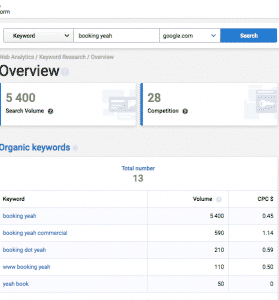One of the longstanding debates amongst those who are fans of .COM domain names and those who accept the New gTLD domain names is whether or not the public confuses a New gTLD domain name ending with a .COM domain name. So, if you have a domain name like whatever.widgets, those who are fans of .COM domain names say that whatever.widgets will lose traffic to someone mistyping it. The argument is that they’ll type in whatever.widgets.com or whateverwidgets.com (and not type in whatever.widgets).
I personally am not necessarily a fan of one or the other .COM vs New gTLD. What I have done, over the past several years, though, is sought to show what works for marketing purposes. I’ve researched, written, and published research and case studies about marketing New gTLD domain names in the real world.
Since today Rick Schwartz, aka the Domain King, brought up the “loss of traffic” that New gTLDs get to .COM, I sought, again, to see a real-world example. In a tweet today, I brought up the website booking.yeah, which is, essentially a phantom domain name. It’s a New gTLD, but it isn’t. There is no .YEAH Top Level Domain.
What Rick did mention, though, was this:
Like you said, Booking.Yeah. I want to see a massive budget like that advertising a new GTLD. Then the test BEGINS!
Okay, so let’s look at that example. It’s widely known that many people mistake the search form for the URL bar in their web browser. In Firefox, for example, the search field is right to the right of where you enter a URL. So, I do know that people mistake both of these fields. That’s good news, as we can actually see how many people do a keyword search for a particular domain name. For example, they’ll put the domain name into the search field, making it a keyword search at Google.
Let’s look at the real (estimated) search numbers (searches per month) for a real-world “new gTLD” domain name, called Booking.Yeah. If you haven’t seen the commercial or any of the commercials, here’s one that I’ve embedded below. There has been a very large marketing budget put towards promoting Booking.Yeah, and that, in turn has caused a lot of searches, and, obviously, a lot of people putting that “domain name” in the search bar. The URL bar, actually, is also a search field if the web browser doesn’t recognize the keyword as a domain name.
I took a look at some data provided by SERPSTAT and SEMrush.com, shown below.
In the “phrase match keywords” data, you can see that there’s an estimated 6600 searches per month for the domain name, booking.yeah (as if it’s a domain name). But, you can see that there are 390 searches for www.booking.yeah (which makes me think that there are people that think it’s a real domain name). That’s the SEMrush.com data.
In the SERPSTAT date, the organic keywords, the www.booking.yeah doesn’t show up, maybe because SERPSTAT searches remove the dot in the keywords. The numbers are similar, with about 5400 people searching per month (versus 6600 according to semrush.com). I’m assuming that SERPSTAT does remove dots in the kewyords, as the number of searches per month are, in fact, similar (within about 1,000 searches a month).
What’s noticeably absent, though, is the fact that there is no .COM or COM keyword present in any of these searches. If people really did enter .COM or COM somewhere, and people really did mistake a new gTLD domain name for a .COM domain name, wouldn’t there be searches showing up that include “com”? Again, this is a real-world example, using booking.yeah, which does have a huge marketing campaign behind it.


